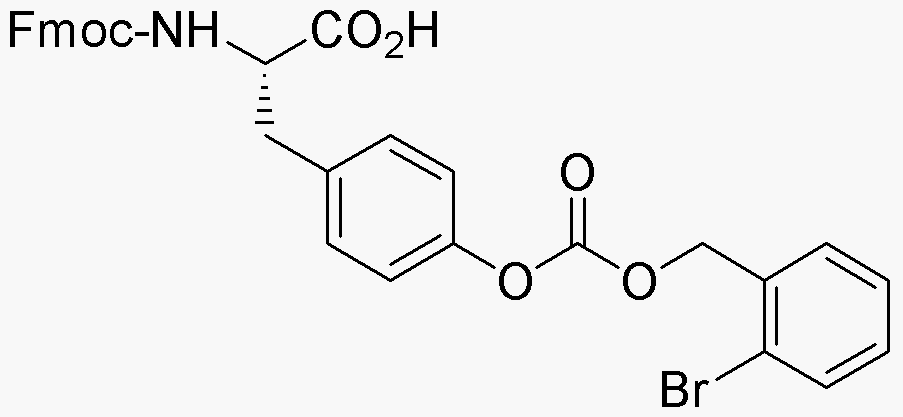Fmoc-O-2-bromo-Z-L-tyrosine is widely utilized in research focused on:
- Peptide Synthesis: This compound serves as a key building block in the synthesis of peptides, particularly in solid-phase peptide synthesis (SPPS), allowing for the creation of complex peptide sequences.
- Drug Development: Its unique brominated structure can enhance the biological activity of peptide-based drugs, making it valuable in the pharmaceutical industry for developing new therapeutics.
- Bioconjugation: The compound can be used in bioconjugation processes to attach peptides to various biomolecules, facilitating the creation of targeted drug delivery systems.
- Research in Cancer Therapy: Due to its potential to modify peptide properties, it is being explored in cancer research for designing targeted therapies that can selectively attack cancer cells.
- Protein Engineering: The compound aids in the modification of proteins to study their structure and function, providing insights that can lead to advancements in biotechnology and molecular biology.
Información general
Propiedades
Seguridad y normativas
Aplicaciones
Fmoc-O-2-bromo-Z-L-tyrosine is widely utilized in research focused on:
- Peptide Synthesis: This compound serves as a key building block in the synthesis of peptides, particularly in solid-phase peptide synthesis (SPPS), allowing for the creation of complex peptide sequences.
- Drug Development: Its unique brominated structure can enhance the biological activity of peptide-based drugs, making it valuable in the pharmaceutical industry for developing new therapeutics.
- Bioconjugation: The compound can be used in bioconjugation processes to attach peptides to various biomolecules, facilitating the creation of targeted drug delivery systems.
- Research in Cancer Therapy: Due to its potential to modify peptide properties, it is being explored in cancer research for designing targeted therapies that can selectively attack cancer cells.
- Protein Engineering: The compound aids in the modification of proteins to study their structure and function, providing insights that can lead to advancements in biotechnology and molecular biology.
Documentos
Hojas de datos de seguridad (HDS)
La SDS proporciona información de seguridad completa sobre la manipulación, el almacenamiento y la eliminación del producto.
Especificación del producto (PS)
La PS proporciona un desglose completo de las propiedades del producto, incluida la composición química, el estado físico, la pureza y los requisitos de almacenamiento. También detalla los rangos de calidad aceptables y las aplicaciones previstas del producto.
Certificados de análisis (COA)
Busque certificados de análisis (COA) ingresando el número de lote del producto. Los números de lote y de partida se pueden encontrar en la etiqueta de un producto después de las palabras "Lote" o "Lote".
Número de catálogo
Número de lote/lote
Certificados de origen (COO)
Este certificado de origen confirma el país en el que se fabricó el producto y también detalla los materiales y componentes utilizados en él y si se deriva de fuentes naturales, sintéticas u otras fuentes específicas. Este certificado puede ser necesario para cumplir con las normativas aduaneras, comerciales y regulatorias.
Número de catálogo
Número de lote/lote
Hojas de datos de seguridad (HDS)
La SDS proporciona información de seguridad completa sobre la manipulación, el almacenamiento y la eliminación del producto.
DownloadEspecificación del producto (PS)
La PS proporciona un desglose completo de las propiedades del producto, incluida la composición química, el estado físico, la pureza y los requisitos de almacenamiento. También detalla los rangos de calidad aceptables y las aplicaciones previstas del producto.
DownloadCertificados de análisis (COA)
Busque certificados de análisis (COA) ingresando el número de lote del producto. Los números de lote y de partida se pueden encontrar en la etiqueta de un producto después de las palabras "Lote" o "Lote".
Número de catálogo
Número de lote/lote
Certificados de origen (COO)
Este certificado de origen confirma el país en el que se fabricó el producto y también detalla los materiales y componentes utilizados en él y si se deriva de fuentes naturales, sintéticas u otras fuentes específicas. Este certificado puede ser necesario para cumplir con las normativas aduaneras, comerciales y regulatorias.


